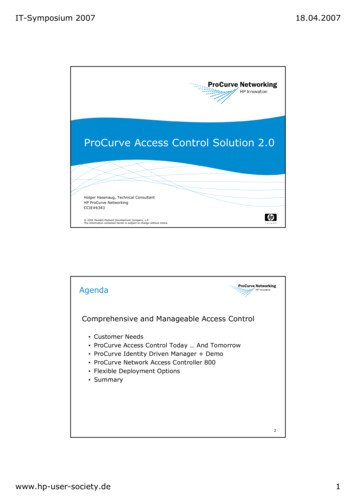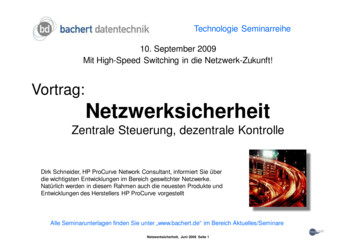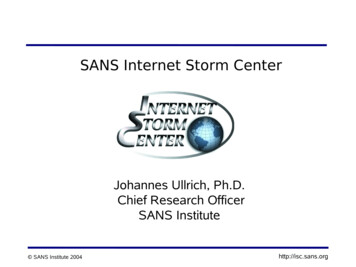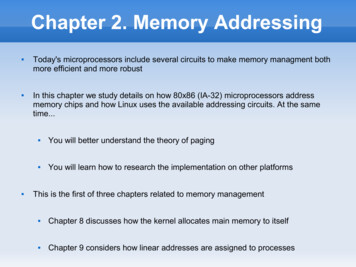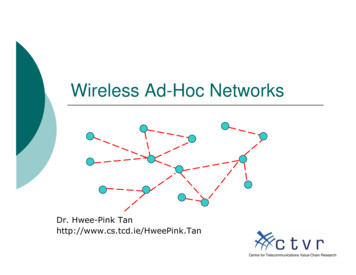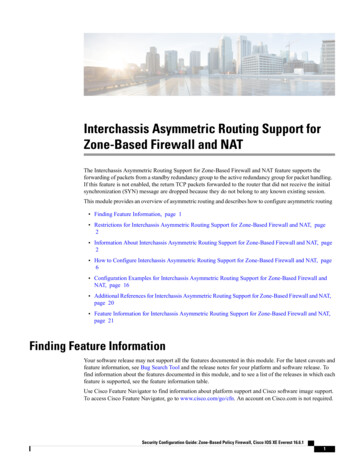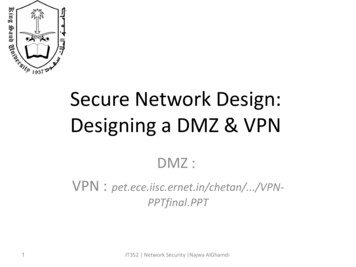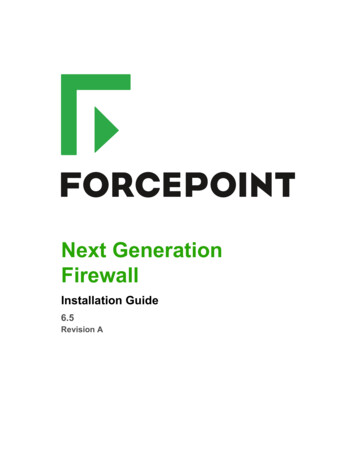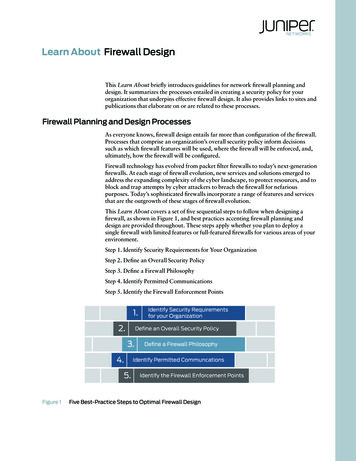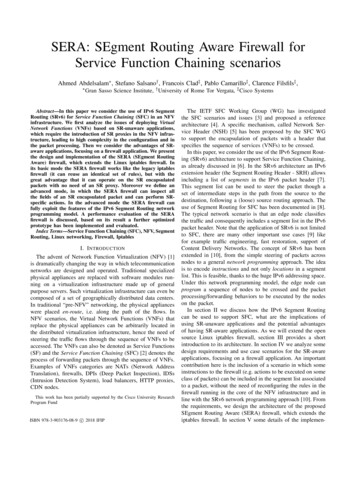
Transcription
SERA: SEgment Routing Aware Firewall forService Function Chaining scenariosAhmed Abdelsalam , Stefano Salsano† , Francois Clad‡ , Pablo Camarillo‡ , Clarence Filsfils‡ , GranSasso Science Institute, † University of Rome Tor Vergata, ‡ Cisco SystemsAbstract—In this paper we consider the use of IPv6 SegmentRouting (SRv6) for Service Function Chaining (SFC) in an NFVinfrastructure. We first analyze the issues of deploying VirtualNetwork Functions (VNFs) based on SR-unaware applications,which require the introduction of SR proxies in the NFV infrastructure, leading to high complexity in the configuration and inthe packet processing. Then we consider the advantages of SRaware applications, focusing on a firewall application. We presentthe design and implementation of the SERA (SEgment RoutingAware) firewall, which extends the Linux iptables firewall. Inits basic mode the SERA firewall works like the legacy iptablesfirewall (it can reuse an identical set of rules), but with thegreat advantage that it can operate on the SR encapsulatedpackets with no need of an SR proxy. Moreover we define anadvanced mode, in which the SERA firewall can inspect allthe fields of an SR encapsulated packet and can perform SRspecific actions. In the advanced mode the SERA firewall canfully exploit the features of the IPv6 Segment Routing networkprogramming model. A performance evaluation of the SERAfirewall is discussed, based on its result a further optimizedprototype has been implemented and evaluated.Index Terms—Service Function Chaining (SFC), NFV, SegmentRouting, Linux networking, Firewall, IptablesI. I NTRODUCTIONThe advent of Network Function Virtualization (NFV) [1]is dramatically changing the way in which telecommunicationnetworks are designed and operated. Traditional specializedphysical appliances are replaced with software modules running on a virtualization infrastructure made up of generalpurpose servers. Such virtualization infrastructure can even becomposed of a set of geographically distributed data centers.In traditional “pre-NFV” networking, the physical applianceswere placed en-route, i.e. along the path of the flows. InNFV scenarios, the Virtual Network Functions (VNFs) thatreplace the physical appliances can be arbitrarily located inthe distributed virtualization infrastructure, hence the need ofsteering the traffic flows through the sequence of VNFs to beaccessed. The VNFs can also be denoted as Service Functions(SF) and the Service Function Chaining (SFC) [2] denotes theprocess of forwarding packets through the sequence of VNFs.Examples of VNFs categories are NATs (Network AddressTranslation), firewalls, DPIs (Deep Packet Inspection), IDSs(Intrusion Detection System), load balancers, HTTP proxies,CDN nodes.This work has been partially supported by the Cisco University ResearchProgram FundISBN 978-3-903176-08-9 c 2018 IFIPThe IETF SFC Working Group (WG) has investigatedthe SFC scenarios and issues [3] and proposed a referencearchitecture [4]. A specific mechanism, called Network Service Header (NSH) [5] has been proposed by the SFC WGto support the encapsulation of packets with a header thatspecifies the sequence of services (VNFs) to be crossed.In this paper, we consider the use of the IPv6 Segment Routing (SRv6) architecture to support Service Function Chaining,as already discussed in [6]. In the SRv6 architecture an IPv6extension header (the Segment Routing Header - SRH) allowsincluding a list of segments in the IPv6 packet header [7].This segment list can be used to steer the packet though aset of intermediate steps in the path from the source to thedestination, following a (loose) source routing approach. Theuse of Segment Routing for SFC has been documented in [8].The typical network scenario is that an edge node classifiesthe traffic and consequently includes a segment list in the IPv6packet header. Note that the application of SRv6 is not limitedto SFC, there are many other important use cases [9] likefor example traffic engineering, fast restoration, support ofContent Delivery Networks. The concept of SRv6 has beenextended in [10], from the simple steering of packets acrossnodes to a general network programming approach. The ideais to encode instructions and not only locations in a segmentlist. This is feasible, thanks to the huge IPv6 addressing space.Under this network programming model, the edge node canprogram a sequence of nodes to be crossed and the packetprocessing/forwarding behaviors to be executed by the nodeson the packet.In section II we discuss how the IPv6 Segment Routingcan be used to support SFC, what are the implications ofusing SR-unaware applications and the potential advantagesof having SR-aware applications. As we will extend the opensource Linux iptables firewall, section III provides a shortintroduction to its architecture. In section IV we analyze somedesign requirements and use case scenarios for the SR-awareapplications, focusing on a firewall application. An importantcontribution here is the inclusion of a scenario in which someinstructions to the firewall (e.g. actions to be executed on someclass of packets) can be included in the segment list associatedto a packet, without the need of reconfiguring the rules in thefirewall running in the core of the NFV infrastructure and inline with the SRv6 network programming approach [10]. Fromthe requirements, we design the architecture of the proposedSEgment Routing Aware (SERA) firewall, which extends theiptables firewall. In section V some details of the implemen-
tation are given. To the best of our knowledge, the SERAfirewall can be considered the first SRv6-aware application.Section VI provides the description of the testbed and theresult of the performance evaluation. Based on these results,we have identified some shortcomings of the iptables designfor our use cases. We implemented and evaluated a proof-ofconcept that shows a significant performance improvement.II. SFC BASED ON IP V 6 S EGMENT ROUTINGFollowing the terminology defined in [4], the SFC encapsulation carries the information to identify the sequence ofService Functions (VNFs) that are required for processing agiven packet. In the SRv6 approach considered here, the IPv6Segment Routing Header (SRH) [7] contains such information.The SRH contains a segment list, a segment in this listidentifies a VNF. Moreover, additional information related tothe VNF chain can be carried in the optional Tag-Length-Value(TLV) section at the end of the SRH.When a VNF that processes the packets is a legacy VNF,which is not aware of the Segment Routing based SFCencapsulation, we refer to it as an SR-unaware application.In this case an SFC proxy is needed, to remove the SFCencapsulation and deliver a clean IP packet to the SR-unawareapplication. Considering our focus on the Segment Routingbased solution, we refer to the SFC proxy as SR-proxy. Forthe packets that are sent by the SR-unaware application, the SRproxy needs to (re)apply the SFC encapsulation after properclassification of the received packets. The operations of theSR proxies tend to be complex and in general they are notefficient. The main issue is that the information contained inthe SFC encapsulation is removed from the packet when thepacket is delivered to the SR-unaware application and mayneed to be re-added to the packet. This process typicallyrequires a lot of state information to be configured in theclassifier components of all nodes of a VNF chain and canconsume a considerable amount of packet processing resourcesin the nodes.Different types of VNFs can process the IP packets in aVNF chain. Some VNFs only need to inspect IP packets (e.g.DPI or network monitoring applications), other can drop oradmit packets (e.g. firewall), other can modify IP and transport layer headers (e.g. NATs), other may need to terminatetransport layer connections and reopen new ones (e.g. HTTPproxies, TCP optimizers). In general, the operations of an SRproxy depend on the type of VNF. If the VNF is not operatingon the connections at transport layer (i.e. it is not modifyingthe 5-tuple of IP and transport layer source and destinationaddresses) it is possible in principle to re-classify the packets,at the price of repeating the flow-level classification in allnodes of the VNF chain. If the VNF is terminating / openingnew transport level connections, it is not always possible tore-classify the packets and associate them to a specific chain.As described in the SRv6 network programming document [10], the SR information can be added to a packet intwo different modes, insert or encap. Figure 1 shows theoriginal IPv6 packet and how it is carried in the two differentencapsulation modes. In the insert mode the SRH header isinserted in the original IPv6 packet, immediately after theIPv6 header and before the transport level header. Note thatthe original IPv6 header is modified, in particular the IPv6destination address is replaced with the IPv6 address of thefirst segment in the segment list, while the original IPv6destination address is carried in the SRH header as the lastsegment of the segment list. In the encap mode the originalIPv6 packet is carried as the inner packet of an IPv6-in-IPv6encapsulated packet. The outer IPv6 packet carries the SRHheader with the segment list.Fig. 1: SRv6 encapsulated packetsAn SR-unaware application is not able to process theSRH information in the traffic it receives. An SR proxy isused to process the SRH information on behalf of the SRunaware application. As discussed above, the behavior and theapplicability of an SR proxy depend on the type of processingof the application. In [8], a set of behaviors of the SR-proxyhave been defined, among them we mention: Static proxy Dynamic proxy Masquerading proxyBoth the Static and the Dynamic proxies support IPv6SR packets encapsulated only in encap mode. They removethe SR information from packets before sending them toan SR-unaware application. These proxies receive back thepackets from the SR-unaware application and reapply the SRencapsulation which includes the information on the VNFchain. They work under the assumption that the specific SRunaware application running in the VNF is inserted in only oneVNF chain, because all packets going out from the VNF arere-associated to the same chain. If multiple VNF chains needsto be supported, a different instance of the VNF is needed foreach chain. The difference between the Static and the Dynamicproxies is that the SR information is statically configured inthe Static case and is read from the incoming packets in theDynamic case.The Masquerading proxy supports SR packets encapsulatedin insert mode. It masquerades SR packets before they are sentto an SR-unaware application, replacing the IPv6 destinationaddress (which correspond to the current segment of thesegment list) with the original IPv6 destination (i.e. the lastsegment in the segment list). When the packets are receivedback from the SR-unaware application, the Masqueradingproxy retrieves the VNF chain information from the SRHheader and changes the IPv6 destination address so that itreflects the current segment of the segment list. This process
is refered to as de-masquerading. The assumption is that theSR-unaware application simply ignores the SRH header andthat the SRH header is preserved in the processing. Moreover,this type of proxy can be only used with applications that donot change the packet headers and just inspect them.Following the above discussion on the SR-unaware applications, we can state that their use in combination with SRproxies is conditioned by some constraints and characterizedby high configuration complexity. It can also be affected byperformance issues. Of course these problems will be facedand solved in practical use cases, considering the importance tosupport legacy SR-unaware applications in NFV deployments.On the other hand, in this work we take a more forwardlooking approach and consider the design and development ofSR-aware applications. Such applications are able to processthe SFC encapsulation included in the IP packets, that is inour scenario the IPv6 SRH header that contains the segmentlist. The greatest benefit of using SR-aware applications isthat the SR proxy is not needed and the SFC informationcarried in the SRH header is preserved when the packetis processed by the application. This approach avoids theneed to maintain state information in the internal nodes. Theconfiguration and management of the NFV infrastructure issimplified and the performance of the NFV enabled nodes isnot affected by complex classification procedures. Moreoveradvanced features are possible by letting the applicationsinteract with the SFC functionality offered by the network.In this paper, we focus on the design and implementationof an SR-aware firewall application, but most of the designconsiderations have a more general applicability to other typesof applications that can be deployed in SR based ServiceFunction Chaining scenarios.III. L INUX IPTABLES FIREWALLA firewall [11] essentially works according to a set of rulesto accept or drop received packets. Each rule is composed ofa condition and an action. The condition is based on set ofattributes of received packets.Once a packet satisfies the condition expressed by a rulecondition, the associated action is performed on that packet.Iptables is a flexible and modular firewall and it is a standardcomponent of most Linux distributions. It is built on top on thenetfilter framework. In this section we provide a short tutorialon Iptables and netfilter architecture and implementation,which will be the base for the design of our solution.A. Netfilter FrameworkThe netfilter framework [12] is a set of hooks in the packettraversal through the Linux protocol stack, which allows accessto packets at different points. The current netfilter implementation provides five different hooks (PREROUTING, INPUT,FORWARD, OUTPUT, POSTROUTING) distributed along thereceive and transmit path of packets as shown in Fig. 2. Kernelmodules can register callback functions at any of these hooks.A callback function, after processing a packet, returns to thenetfilter hook the action to be taken on the packet, such asDROP, ACCEPT, QUEUE (queue for user space processing).Fig. 2: Netfilter hooks and their associated tablesB. IptablesIptables represents the userspace implementation whichallows access to the kernel-level netfilter framework hooks.It defines a set of rules that instruct the kernel what to dowith packet coming to or traversing the protocol stack. Theimplementation of netfilter includes some pre-defined tables,as shown in Figure 2. Each table has a set of chains whereiptables rules can be inserted. The supported tables are: filter( the default table, it contains rules that are used to filterIP packets); nat (mainly used to re-write the source and/ordestination addresses of IP packets); mangle (a specializedtable for mangling packet as they go through the kernel);raw (mainly used for connection tracking). Each iptables ruledefines a set of matching criteria based on information fromdifferent layers of the protocol stack. Once the packet matchesa rule, iptables takes an action on this packet. The standardactions are: ACCEPT, DROP, or QUEUE. Those correspond tothe callback functions return values. Listing 1 shows examplesof iptables rules.C. Iptables extensionsThe iptables framework is modular and extendible. Newmatch extensions and target extensions can be developedseparately and added to the iptables as new modules.Listing 1: Examples of iptables rules# Standard iptables rule# Matches destination address of a packetip6tables -I INPUT -d fc00:d1::/64 -j DROP# Extended iptables rule# Matches destination address and hop-by-hop headerip6tables -I INPUT -d fc00:d1::/64 \-m hbh --hbh-len 40 -j DROP
Match extensions are used to add more matching optionsto iptables. They can be used alone or in combination withthe default match options. They provide the ability to havesophisticated iptables rules in order to look deeper into IPpackets. e.g., hbh, which matches the parameters in IPv6 Hopby-Hop extensions header. An example of extended iptablesrule is shown in Listing 1.Target extensions are new actions added to the default onesof iptables. A new iptables target usually performs an actiondifferent from the default ones (ACCEPT, DROP, etc.,). It canbe used for logging/profiling or it can modify the packet beforereturning it back to the netfilter framework. Destination NAT(DNAT) is an example of iptables target extension, which isused to modify the destination address of a packet.IV. SE GMENT ROUTING AWARE (SERA) FIREWALLIn an SRv6 SFC scenario, the VNFs are deployed overthe servers of the NFV infrastructure. The Segment RoutingHeader (SRH) is added to packets to enforce a VNF chain,i.e. the sequence of VNFs to be crossed by the packets. TheSR-unaware applications rely on the SR-proxy that removesthe SRH from the packet. On the other hand, the SR-awareapplications are capable of processing the SR informationin the packets. We focus on a specific type of SR-awareapplications, namely a firewall application. In this section,we start by analyzing some design requirements and usecase scenarios for the SR-aware applications. The followingconsiderations are focused on a firewall application, but theyhave a more general value as they can be applied to similarapplications that needs to be deployed on an SR based SFCenvironment (e.g. DPI, IDSs). We assume that an SR-awarefirewall should support two working modes: basic mode andadvanced mode.In the basic mode the SR-aware firewall must be ableto work as a legacy firewall, but with no need of the SRproxy. In particular, the SR-aware firewall should be able touse the same set of rules defined for the legacy firewall andapply them directly to the SFC encapsulated packets that carrythe SRH information. It must be able to handle SR packetsencapsulated in encap as well as insert modes and logicallyapply the rules to the original packets rather than to theSFC encapsulated packets. To make a concrete example, if anexisting rule includes a condition on the source IPv6 addressand the original IPv6 packet has been encapsulated in (IPv6in-IPv6) it makes no sense to consider the IPv6 source addressof the received packet as the condition should be checked onthe source address of the packet. The use case scenario is tovirtualize the legacy firewalls, executing them in servers onthe NFV infrastructure, without changing the legacy rules andwith no need of SR-proxy functionality.In the advanced mode the SR-aware firewall should supportrules with extended conditions that can explicitly includeattributes not only from the original packet but also from theSRH and the outer packet. In particular, the SR-aware firewallcould leverage SRv6 SID arguments, TLVs, or TAG. It couldalso apply differentiated processing based on the active SRv6SID (i.e., apply different rule sets for different SIDs). As forthe actions, in the advanced mode the SR-aware firewall shouldbe able to support some SR-specific actions. For example, anSR-specific action could be to skip the next SID in the segmentlist, so that it is possible to operate a “branching” instead ofthe usual linear exploration of the VNF chain, when someconditions on the packet are met. A use case scenario for thisfeature is to consider a service chain which includes a firewallfollowed by an Intrusion Detection System and allow skippingthe IDS for a subset of traffic that matches some conditions. Afurther requirement is that the SR-aware firewall applicationshould be able to select the actions to be performed basedon information contained in the SID. This is aligned with theSRv6 network programming approach of minimizing the stateinformation maintained in the nodes and storing explicit stateinformation in the packets. The use case scenario in this case isthat instead of re-configuring some firewall rules in a specificfirewall running in the core of the NFV infrastructure, it ispossible to obtain the same result by changing a SID in theSID list that is injected to the packet in the edge node. Thebig advantage is that the reconfiguration is only needed in theedge node, which in any case has to manage per-flow state toperform the classification operations.In the following subsections we propose the architecture ofthe SERA firewall (for basic and advanced modes) that meetsthe above requirements, extending the Linux iptables.A. SERA basic modeIn the basic mode, SERA is an SR-aware firewall that canapply the normal firewall processing to the original packetseven if they have an SR based SFC encapsulation. Theproposed packet processing architecture is shown in Figure 3.Each received packet goes through an SR pre-processor thatsplits traffic into SR and non-SR traffic. Non-SR traffic isprocessed as in an SR-unaware firewall, as represented withthe solid-line path in Figure 3. SR traffic follows a differentpath through the firewall, represented with double-line pathin Figure 3. In this path, the firewall evaluates the definedrules on the original packet, properly taking into account theimpact of the SR encapsulation. It supports both encap andinsert mode, which implies that the original IPv6 source anddestination information of received packets may be encodeddifferently as follows: Encap mode: original source and destination are the onesof the packet.Insert mode: packets have only one IPv6 header. Theoriginal source information is in the source address of theIPv6 header, while the original destination is encoded asthe last SID in the SRH.The Inner match functional block is responsible for getting theoriginal source and destination information from SR packetsand compare them to the defined rules. Once a packet hits acondition of a rule, the associated standard action (ACCEPT,DROP, etc.) is triggered on that packet.
B. SERA advanced modeIn the advanced mode, SERA extends the iptables capabilities by offering new matching capabilities and new SRspecific actions. It introduces new iptables rules (SERA rules)that have extended conditions involving attributes from outerpacket, inner packet, and the SRH header. The architectureof advanced mode (Figure 4) is defined incrementally withrespect to the basic mode (Figure 3), by adding the SRHmatch functional block and replacing the Action block with theExtended Action block. Since the matching could be performedon both the original and the outer packet headers, the SR trafficfollows a more complex path, as shown in Figure 4. Unlike inthe basic mode SERA, all received packet are first processedby the Outer match block, which applies parts of the extendedrules on the outer packet. The SR pre-processor does the samejob as in the basic mode SERA by splitting traffic into nonSR and SR traffic. Non-SR traffic goes directly to the Actionfunctional block while SR traffic is directed to the the Innermatch block. The Inner match block works as in the basicmode, but the rules that drive its behavior are written in adifferent way. For example, with an extended rule it is possibleto match on the outer source and destination IPv6 addresses(denoted as src, dst) and on the original ones (denoted asinner-src, inner-dst). The Inner match block takescare of the matching of the inner source and destination(the ones of the original packet). The SRH match block isconcerned with the matching between SRH extension part ofthe rules and the SRH of received SR packets. Finally, eachpacket (SR or non-SR) that satisfies the matching conditionof a rule goes to the Extended Action block. It extends theAction block present in the architecture of the Basic mode byallowing the introduction of SR-specific actions in addition tothe standard ones.An SR-specific action is an advanced action that can beapplied to SR-encapsulated packets. It may modify or processSR-encapsulated packets based on SRH information. We listhere some examples of SR-specific actions, but the set of theseactions can be extended to cover more complex SFC use-cases. seg6-go-next: the default action of the SEG6 target.It is similar to the Endpoint function from the SRv6 network programming model [10]. It sends packets towardsthe next SID from SRH. The seg6-go-next serves asan ACCEPT action for SRv6 encapsulated packets.seg6-skip-next: it instructs the SERA firewall toskip the next SID in the SRH.seg6-go-last: it instructs the SERA firewall to skipthe remaining part of the segment list and process the lastsegment.seg6-eval-args: the generic action that supportsSRH programmed actions.Following the traditional iptables model, the above definedSR-specific actions are included in statically configured ruleswhich are executed in a SERA firewall running as a VNF.Taking into account the concepts of the SRv6 programmingmodel, we have designed a more dynamic approach, whichFig. 3: Architecture of basic mode SERAallows to define the action to be executed as a result of amatch on a packet by packet basis, by putting informationin the Segment IDentifier (SID). For this purpose, a specialSR-specific action is defined, called eval-args. It does notrepresent a concrete action, but instructs the SERA firewall tolook into the current SID to find the action to be executed. Asdescribed in [10], an SRv6 local SID is an IPv6 address thatcan be logically split into three fields: LOC:FUNCT:ARGS.LOC uses the L most significant bits, ARGS the R rightmostbits and FUNCT the remaining 128 (L R) bits in themiddle. In our case, the LOC part is used as a locator toforward the packets to the NFV node that runs the firewall,and it is advertised by the routing protocols. The FUNCTpart identifies a specific VNF on the NFV node (in our casethe SERA firewall instance). The ARGS part may containinformation required by the VNF and may even change on aper-packet basis. Note that the ARGS part will be ignored inmost cases (or omitted setting R 0), whenever there is no needto carry additional information in the SID. To give an example,the LOC field can be 64 bits long and uniquely identify anNFV node. This leaves 128-64 64 bits for the identificationof the VNF in the NFV node and for the arguments if needed.In the advanced mode of SERA it is possible to use theARGS part of the SID to encode a firewall action to beexecuted in case of match. This requires that a set of rules withaction eval-args is configured in the SERA firewall. For allpackets that match one of these rules, the action to be executedis contained in the ARGS field of the SID. The advantage ofthis approach is that it is possible to (re)configure the actionto be executed on a given subset of packets by operating atthe network edge, with no need to update the configuration ofthe SERA firewall instance running in the core of the NFVinfrastructure.V. I MPLEMENTATIONWe implemented the SERA firewall as an extension ofLinux iptables described in section III.
the advanced SERA architecture. The ip6t SEG6 moduleimplements the Extended Action. It is a new target (SEG6)for iptables rules that supports a set of SR-specific actions.To support the advanced mode SERA at user-space level, weextended the iptables user-space utility with two new sharedlibraries: libip6t srh and libip6t SEG6. They allowthe iptables user to define SERA rules. These rules can haveattributes from outer packet, inner packet, and SRH. List. 2shows a list of match options supported by the libip6t srhextension.The ibip6t SEG6 extension supports the new SR (SEG6)target with some SR-specific actions (shown in List. 3). ForFig. 4: Architecture of advanced mode SERAA. Implementation of basic mode SERAIn the Linux kernel the ip6 tables module is responsible for checking the iptables rules against the receivedpackets. It implements the ip6 packet match() functionthat evaluates the defined iptables rules against the outermostIPv6 header of a received packet. In order to implement thebasic mode of the SERA firewall, we extended the existingip6 tables module to operate according to the architectureshown in Figure 3. We added the SR pre-processor block.The SR packets are forwarded to the Inner match functionalblock, implemented in the inner match() function, whichevaluates iptables rules against the original packet. It supportsSR packets encapsulated in both encap and insert mode.We added a new sysctl parameter (ip6t seg6) toswitch between legacy iptables mode and SERA basicmode. The system administrator can enable the SERA basic mode on the fly with the command: sysctl -wnet.ipv6.ip6t seg6 1, which activates the SR preprocessor.We have realized a first version of basic mode SERA thatimplements only a subset of the normal classification rules,namely those involving the IP src and destination addresses.On this first version we have performed the evaluation that isreported in the paper. Then we have implemented a secondversion that supports all the classification rules and it is nowavailable at [13].B. Implementation of advanced mode SERAWe implemented the advanced mode SERA by exploiting the iptables extension features. We added a new matchextension as well as a new target extension to the iptablesimplementation both at kernel and user-space levels. Thanks tothese extensions it is possible to match on the SRH fields, thisallow to have a full control on where the packets is directed(the next SIDs) and which nodes it has crossed before.At kernel level, we implemented two additional kernel modules: the ip6t srh as match extension and ip6t SEG6as target extension. The ip6t srh module implements theSR pre-processor, the Inner match, and the SRH match fromListing 2: Options of srh match extension#ip6tables -m srh -hsrh match options:[!] --inner-src[!] --inner-dst[!] --srh-next-hdr[!] --srh-len-eq[!] --srh-len-gt[!] --srh-len-lt[!] --srh-segs-eq[!] --srh-segs-gt[!] --srh-segs-lt[!] --srh-last-eq[!] --srh-last-gt[!] --srh-last-lt[!] --srh-tag[!] --srh-psid
of having SR-aware applications. As we will extend the open source Linux iptables firewall, section III provides a short introduction to its architecture. In section IV we analyze some design requirements and use case scenarios for the SR-aware applications, focusing on a firewall application. An important
